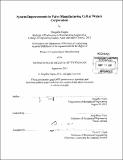System improvements in valve manufacturing cell at Waters Corporation
Author(s)
Gupta, Snegdha
DownloadFull printable version (17.83Mb)
Other Contributors
Massachusetts Institute of Technology. Department of Mechanical Engineering.
Advisor
Jung-Hoon Chun.
Terms of use
Metadata
Show full item recordAbstract
This thesis addresses the challenge of improving on-time delivery performance of stators in the high mix valve manufacturing cell at the Milford facility of Waters Corporation with a focus on efficient line design without exceeding the average WIP levels observed in the current system. A detailed study of the current process was done and it was concluded that the poor on-time delivery performance of stators to the assembly department could be attributed to the unacceptably long fabrication lead times-due to the long waiting induced by the fabrication of a high mix of 28 different types of stators- and the lack of an efficient inventory management policy that makes the system susceptible to extreme situations of either stock-outs or inventory explosion. Therefore, a pull-type production system with a responsive fabrication line establishing WIP control and an end of line standardized finished goods inventory management was designed and implemented. An efficient line design was developed by dedicating lines for high volume and high mix parts and by placing in-process buffers to implement a Kanban based pull-type production process that in turn limits the amount of WIP as well. An overall lead time reduction from 21 days to 3 days was achieved through the implementation of this line design and a 40% reduction in WIP levels was observed simultaneously. For standardizing the finished goods inventory management in order to maintain high service levels while eliminating the possibility of WIP explosion, a mixed inventory review policy or the (s,S) policy-that uses a re-order point to trigger production at appropriate times and a base stock level that maintains an upper control limit on the inventory levels- is suggested for implementation. With this policy, a calculated service level of at least 96% is expected even for high demand periods alongside a 50% reduction in average finished goods inventory levels.
Description
Thesis: M. Eng. in Manufacturing, Massachusetts Institute of Technology, Department of Mechanical Engineering, 2013. Cataloged from PDF version of thesis. Includes bibliographical references (page 132).
Date issued
2013Department
Massachusetts Institute of Technology. Department of Mechanical EngineeringPublisher
Massachusetts Institute of Technology
Keywords
Mechanical Engineering.